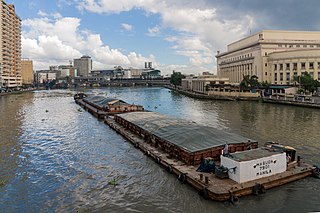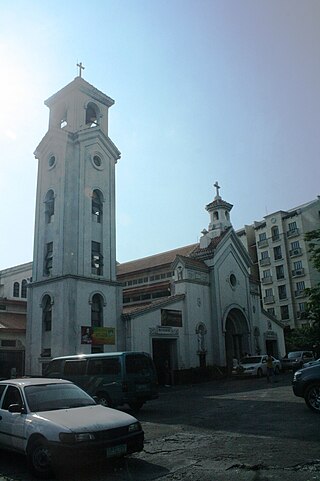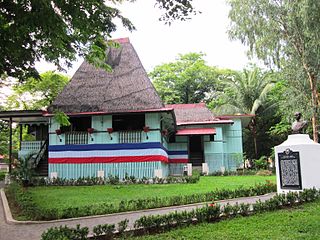
The Pasig River is a water body in the Philippines that connects Laguna de Bay to Manila Bay. Stretching for 25.2 kilometers (15.7 mi), it bisects the Philippine capital of Manila and its surrounding urban area into northern and southern halves. Its major tributaries are the Marikina River and San Juan River. The total drainage basin of the Pasig River, including the basin of Laguna de Bay, covers 4,678 square kilometers (1,806 sq mi).

San Juan, officially the City of San Juan, is a 1st class highly urbanized city in the National Capital Region of the Philippines. According to the 2020 census, it has a population of 126,347 people. It is geographically located at Metro Manila's approximate center and is also the country's smallest city in terms of land area.

Pinaglabanan Memorial Shrine is a Filipino national shrine and park along Pinaglabanan Street in the city of San Juan, Metro Manila, Philippines. This was built to commemorate the heroism of the Katipuneros who laid siege to Almacen de Polvorín, an armoury belonging to the Spanish Colonial Government, becoming the first battle of the Philippine Revolution against the Spanish Empire.
Eduardo de los Santos Castrillo was a renowned Filipino sculptor.

The La Mesa Dam and Reservoir is an earth dam in Quezon City, Philippines. Its reservoir can hold up to 50.5 million cubic meters, occupying an area of 27 square kilometers (10 sq mi). It is part of the Angat-Ipo-La Mesa water system, which supplies most of the water supply of Metro Manila.
Camp Gen. Rigoberto Atienza or Camp Atienza in Libis, Quezon City was named after the 9th Chief of Staff of the Armed Forces of the Philippines. Camp Atienza serves as the headquarters of the 51st Engineer Brigade, Philippine Army.
The Battle of San Juan del Monte also refers as "Battle of Pinaglabanan" took place on August 30, 1896. It is considered as the first major battle of the Philippine Revolution, which sought Philippine independence from Spain. The first battle cry of the Katipunan coincided with the pealing of church bells at nine o'clock on the night of August 29, 1896.

BF Homes Parañaque, officially Barangay BF Homes, is a gated community and administrative division in southern Metro Manila, the Philippines. It is one of the sixteen barangays that make up Parañaque and is the city's largest barangay and southernmost village. As a subdivision, the local term for gated community, its territory includes portions of neighboring cities, Las Piñas and Muntinlupa. It was formerly known as Las Piñas-Parañaque BF Homes and was developed by Banco Filipino owner Tomas Aguirre in 1968. The development was part of the BF Homes project, alongside its sister branches in Quezon City, Caloocan, and Naga, and became fully operational by early 1970. Philippine media refer to it as "the biggest subdivision in Asia". The larger portion of the development in Parañaque was carved out of the village of San Dionisio to form its own barangay in 1978.
Numerous events and festivals are held annually in Metro Manila. They include:

The Battle of Manila of 1896 occurred in Manila in the Spanish colony of the Philippines during the Philippine Revolution. Katipunan under Andres Bonifacio attempted to take the city but the attempt failed, and Bonifacio retreated to the city's outskirts. The Battle of San Juan del Monte was joined a day later when Bonifacio attempted to capture the San Juan's powder magazine, but this too failed.

Saint John the Baptist Parish is a 19th-century Roman Catholic church in San Juan, Metro Manila, Philippines. It belongs to the Roman Catholic Archdiocese of Manila.

The Apolinario Mabini Shrine is a historic site in Santa Mesa, Manila, Philippines. It is noted for being the residence of Filipino military leader Apolinario Mabini who figured in the Philippine Revolution. Originally situated along the Nagtahan River, the structure was moved to the Polytechnic University of the Philippines main campus in Santa Mesa, Manila in the mid-2000s.

Colonel Bonny Serrano Avenue, formerly named and still referred to as Santolan Road, is a major east–west thoroughfare in the Eastern Manila District of Metro Manila, Philippines, running between San Juan and Quezon City. It forms the northern limit of San Juan and the southern limit of Quezon City's New Manila and Cubao districts and links the Philippine National Police headquarters in Camp Crame with the Armed Forces of the Philippines headquarters in Camp Aguinaldo. The avenue runs from the border of barangays Corazón de Jesús, St. Joseph (Halo-Halo), Pasadena, and Little Baguio in San Juan in the west to barangays Libís and Blue Ridge B near Quezon City's border with Marikina in the east. It was named after the decorated Korean War hero, Venancio "Bonny" Serrano.

The following is an alphabetical list of articles related to the Philippine capital region of Metro Manila.

The Pamitinan Protected Landscape is a Philippine protected area of approximately 608 hectares in the Sierra Madre mountain range, just 34 kilometres (21 mi) northeast of Manila. It contains and protects the Montalban Gorge formed by the Marikina River that separates Mount Pamitinan and Mount Binacayan in the municipality of Rodriguez in Rizal. Established in 1996 through Proclamation No. 901 issued by President Fidel Ramos, the park is originally a component of the Mariquina Reserve founded in 1904 to protect the watershed of the Marikina River that supplied water to the city of Manila from the Wawa Dam located just above the Montalban Gorge in the early 1900s.

Museo ng Katipunan is a history museum in the city of San Juan in Metro Manila, Philippines dedicated to the Katipunan. It is situated within the grounds of the Pinaglabanan Shrine.
Museo El Deposito is a history museum in the city of San Juan in Metro Manila, Philippines, which features the Carriedo water system, including the El Deposito underwater reservoir.
Francisco Carriedo y Peredo was a Cantabrian military officer, politician, and philanthropist. He was a general of the Santa Familia galleon and served as Capitán General of the Philippines.

The Marikina North Sewage Treatment Plant is a sewage treatment plant in Marikina, Metro Manila, Philippines. Managed by Manila Water, the facility is the largest sewage treatment plant in the Philippines processing 100 million liters (26,000,000 U.S. gal) of used water daily.















